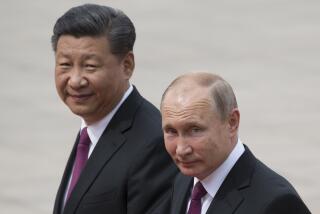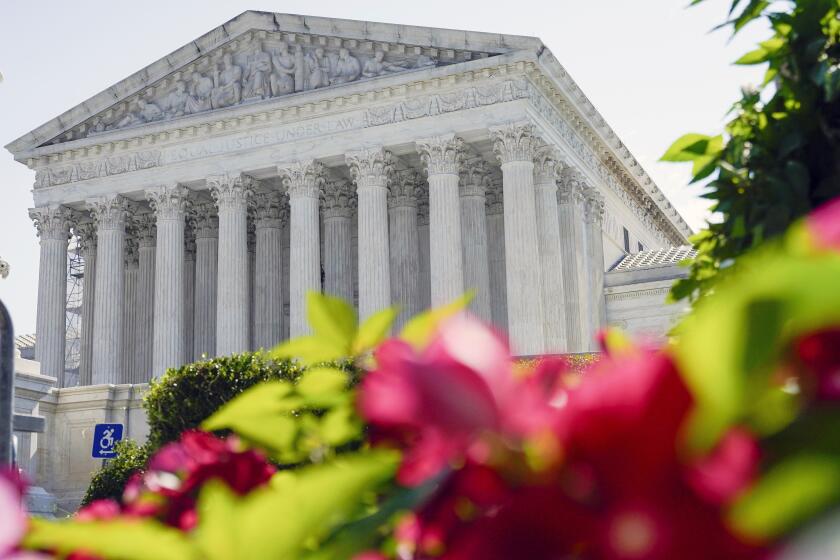Bush Names Utah Gov. to Run EPA
President Bush nominated Utah Gov. Mike Leavitt on Monday to head the Environmental Protection Agency, again turning to his fraternity of governors to help him address the nation’s problems.
In Leavitt, Bush chose a like-minded Republican who wants to shift authority over pollution control from the federal government to the states and who favors voluntary cleanups by industry rather than mandatory government regulations.
Leavitt “rejects the old ways of command and control from above,” Bush said. He hailed the 52-year-old, three-term governor as “a trusted friend” and a man who “understands the obligations of environmental stewardship.”
Industry groups, applauding Leavitt’s nomination, said he would take a balanced approach to pollution control.
But environmentalists said Leavitt had a poor record on protecting Utah’s air, water and land and would probably weaken environmental protections nationwide in the lead job at EPA.
If confirmed by the Senate, Leavitt will take charge of the agency that until June was run by Christie Whitman, the former governor of New Jersey, who often battled the White House to make environmental regulations more protective than others in the administration sought.
Environmental activists said they worried that Leavitt would not fight back the way Whitman did. As a result, they predicted, the EPA would become more friendly to polluting industries.
“Although administrator Whitman got rolled on just about every environmental issue, she came from a Republican moderate background and at times was an independent voice in the administration,” said Jim Angell, a Denver-based staff attorney for Earthjustice Legal Defense Fund, an environmental law firm. “That’s a very different background than the Western radical anti-federal views espoused by people like Gov. Leavitt. This is a dramatic lurch rightward.”
Bush, defending Leavitt’s record in Utah, said the governor had gained “widespread respect for handling environmental issues in a spirit of openness and bipartisanship.”
Top on the list of Leavitt’s accomplishments was his role as the co-chairman of a commission of 13 governors and 13 tribal leaders who developed a plan to address the haze that mars the beautiful vistas at the Grand Canyon.
In his brief remarks, Leavitt described a visit to the Grand Canyon when he was 8 years old as a defining moment in his environmental awareness. He returned to the exact location 36 years later, as governor, only to confront a brown haze at the national monument.
Leavitt said that as EPA administrator, he would apply the lessons he learned when trying to get that diverse group of leaders to agree on a strategy to combat the haze.
“There is no progress polarizing at the extremes, but ... there’s great environmental progress when we collaborate in the productive middle,” Leavitt said during a news conference with the president at a small hotel meeting room in Aurora, just outside Denver.
Since being elected governor in 1992, Leavitt has not won friends among Utah’s environmentalists. They point out that, according to EPA data, industries release more toxins into the air, water and land in Utah than in any other state except Nevada.
“I have never seen Gov. Leavitt demonstrate any passion toward working for environmental protection,” said Jason Groenewold, who represents two Utah environmental groups, Families Against Incinerator Risk and the Healthy Environment Alliance of Utah.
Instead, Leavitt continued a long pattern of neglecting Utah’s serious environmental problems, such as large stockpiles of chemical weapons and landfills full of radioactive waste, Groenewold said. Environmentalists also criticized Leavitt for supporting a controversial highway through fragile wetlands close to the Great Salt Lake -- a plan that failed.
They took issue with him for making a deal with Interior Secretary Gale A. Norton that changed the way the federal government manages millions of acres of land in Utah that had been proposed for permanent protection as wilderness. The deal opened the possibility of oil drilling and off-road vehicle travel in the state’s red rock canyon region, which had been temporarily out of bounds for uses that would spoil the area’s wilderness characteristics.
But representatives from industries in Utah and across the nation said Leavitt was a good choice because he would seek their advice as he made pollution control more flexible.
“He has enforced the laws of the state, and he has also tried to promote the concept of cooperation between government and business to try to resolve issues,” said Louie Cononelos, director of government and public affairs for Kennecott Utah Copper Corp., one of the state’s largest mining companies and largest polluters. “I give him very, very high marks.”
One of the tasks Leavitt likely will have early in his tenure at the EPA is rewriting the regulations that dictate whether older coal-fired power plants can undergo major renovations without the addition of modern pollution-control devices.
Representatives of energy companies that want the EPA to write lenient rules applauded Leavitt’s nomination.
“We are pleased that a governor with a strong record of consensus-building is President Bush’s choice,” said Scott Segal, director of the Electric Reliability Coordinating Council, a coalition of coal-fired power plants.
More to Read
Start your day right
Sign up for Essential California for news, features and recommendations from the L.A. Times and beyond in your inbox six days a week.
You may occasionally receive promotional content from the Los Angeles Times.






